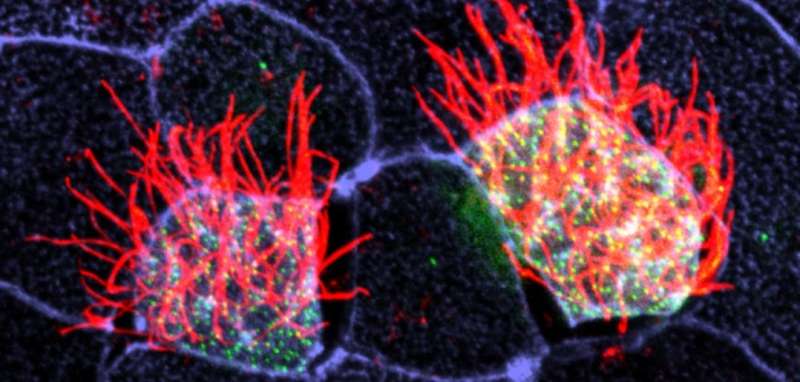Key polarity protein uncovered

Northwestern Medicine scientists have identified a protein called CLAMP as crucial to a mechanism that organizes cells and allows some to perform specialized functions, according to a study published in the Journal of Cell Biology.
While planar cell polarity (PCP) is a mechanism critically important for early development, it also remains relatively understudied in vertebrates, according to Brian Mitchell, Ph.D., associate professor of Cell and Molecular Biology and senior author for the study.
PCP uses protein signaling pathways to shape a cell's cytoskeleton and align the internal structure of cells along an axis. According to Mitchell, PCP is particularly important for ciliated cells: cells that use small hair-like structures to perform a variety of functions, including carrying mucus out of the lungs and distributing cerebrospinal fluid within the ventricles of the brain.
"You need to have these cilia beat in one direction, so they generate fluid flow in one direction," said Mitchell, who is also a member of the Robert H. Lurie Comprehensive Cancer Center.
While scientists have a firm grasp on the cytoskeletal changes that result in polarity, the signaling cues that precede those physical changes remain poorly understood, according to Mitchell.
In the current study, investigators zeroed in on CLAMP, a protein previously known to interact with the cytoskeleton. Mitchell and his colleagues deleted the CLAMP protein from frog embryos and observed its effect on ciliated cells; they found this change completely broke down planar polarity.
"We think because it changes the ability of cells to communicate with one another," Mitchell said.
Further investigation is necessary, Mitchell said, in order to explore this new perspective on diseases that affect the cilia, including respiratory conditions.
"As we learn more about polarity, we may realize problems clearing mucus from the lungs aren't always caused by low cilia motility, but could be caused by incorrect polarity," Mitchell said. "We've seen a lot of mutations in frogs that don't affect motility but cause the cilia to point in the wrong direction."
However, simply identifying the protein involved in the signaling process is just the tip of the iceberg, according to Mitchell.
"This really creates a link between polarity and the cytoskeleton, but we still don't really know what this protein, CLAMP, is doing," Mitchell said. "It's found in all animals, from single-celled organisms all the way up to humans, so we need more research to figure out exactly how it's involved."
More information: Sun K. Kim et al. CLAMP/Spef1 regulates planar cell polarity signaling and asymmetric microtubule accumulation in theXenopusciliated epithelia, The Journal of Cell Biology (2018). DOI: 10.1083/jcb.201706058
Journal information: Journal of Cell Biology
Provided by Northwestern University



















